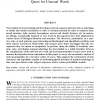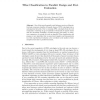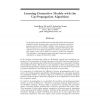357 search results - page 64 / 72 » The Use of Classifiers in Sequential Inference |
RECOMB
2002
Springer
14 years 9 months ago
2002
Springer
The problem of characterizing and detecting recurrent sequence patterns such as substrings or motifs and related associations or rules is variously pursued in order to compress da...
AIEDU
2005
13 years 8 months ago
2005
The Bayesian framework offers a number of techniques for inferring an individual's knowledge state from evidence of mastery of concepts or skills. A typical application where ...
DLOG
2010
13 years 6 months ago
2010
Abstract. One of the most frequently used inference services of description logic reasoners classifies all named classes of OWL ontologies into a subsumption hierarchy. Due to emer...
ICASSP
2011
IEEE
13 years 9 days ago
2011
IEEE
Real-time functional magnetic resonance imaging (rtfMRI) enables classification of brain activity during data collection thus making inference results accessible to both the subj...
NIPS
1997
13 years 10 months ago
1997
Up-propagation is an algorithm for inverting and learning neural network generative models. Sensory input is processed by inverting a model that generates patterns from hidden var...



